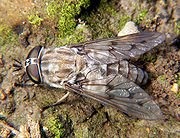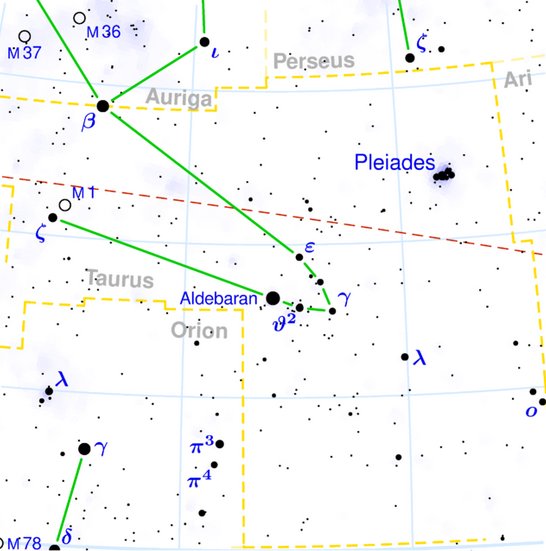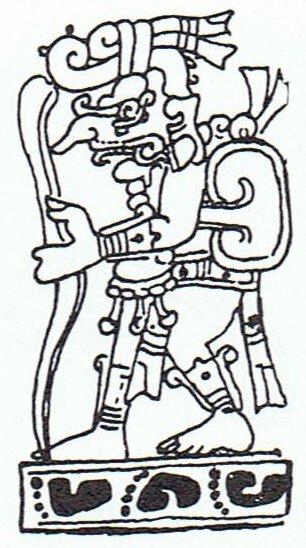Once again. Should we count from Acrux (*187) to Cursa (*76) we
will find the distance to be around 76 - 187 + 365 = 365 - 111 =
254 days.

This suggests Cursa (β
Eridani, the Foot-stool of Orion) marked the place 100 days
before day 3 * 118 = 354. Hence the design of Gb2-35 (→ 2 * 118
- 1)

with 3 periods followed by a missing 1 (→ the little boy in
front at bottom left in the Roman illustration of Uranus).
To repeat:
|
no glyph |
 |
 |
 |
 |
|
Ca1-1 |
Ca1-2 |
Ca1-3 |
Ca1-4 |
|
koia |
ki te hoea |
ki te henua |
te rima te hau tea |
|
Sept 20 (263) |
21 |
Equinox |
LONG SAND-BANK |
24 (*187) |
 |
|
CLOSE TO THE FULL
MOON: |
|
REAR SPOUT (0h) |
ALGENIB PEGASI |
March 23 |
24 |
Julian equinox (84) |
 |
 |
 |
 |
 |
 |
|
Ca3-21 (68 +
4) |
Ca3-22 (365 /
5) |
Ca3-23 (4 +
10 weeks) |
Ca3-24 (75) |
Ca3-25 (68 + 8) |
|
tagata tuu rima ki ruga |
te maitaki |
te henua |
Rei hata ia |
tagata rogo |
Hata. 1. Table,
bureau. P Pau.: afata, a chest, box.
Mgv.: avata, a box, case, trunk,
coffin. Mq.: fata, hata, a
piece of wood with several branches serving
as a rack, space, to ramify, to branch;
fataá, hataá, stage, step, shelf.
Ta.: fata, scaffold, altar. 2.
Hakahata, to disjoint; hakahatahata,
to loosen, to stretch. P Pau.: vata,
an interval, interstice. Mgv.: kohata,
the space between two boards, to be badly
joined; akakohata, to leave a space
between two bodies badly joined; hakahata,
to be large, broad, wide, spacious, far off.
Mq.: hatahata, fatafata,
having chinks, not tightly closed,
disjointed. Ta.: fatafata, open. 3.
Hatahata, calm, loose, prolix, vast.
Mgv.: hatahara, broad, wide,
spacious, at one's ease. Ta.: fatafata,
free from care. Mq.: hatahata, empty,
open. 4. Hatahata, tube, pipe,
funnel. Churchill. ... The division into
quarters of a 28-series can be applied to
the main phases of the moon ... The separate
subgroup (29 makere - 30 hata)
consists of the names of two types of
cockroaches, but in related eastern
Polynesian languages these names can also be
explained on a different level. MAO.
makere, among others, 'to die', and
whata, among others, 'to be laid to rest
on a platform', deserve special attention.
The theme hinted at is one of death and
burial. In our scheme they occur at just
that time when the moon 'has died'!
.jpg)
... Teke
said to Oti, 'Go and take the hauhau tree,
the paper mulberry tree, rushes, tavari
plants, uku koko grass, riku ferns, ngaoho
plants, the toromiro tree, hiki kioe plants
(Cyperus vegetus), the sandalwood
tree, harahara plants, pua nakonako plants,
nehenehe ferns, hua taru grass, poporo
plants, bottle gourds (ipu ngutu),
kohe plants, kavakava atua ferns, fragrant
tuere heu grass, tureme grass (Dichelachne
sciurea), matie grass, and the two kinds
of cockroaches makere and hata.'
Oti and all his assistants went and took the
hauhau tree with them. All kinds of things [te
huru o te mee] (i.e., plants) and
insects [?] were taken along.
[E:69]
Oti said to his
assistants [toona titiro], 'Take all
the things (i.e., the plants) on board the
canoe and leave them there!' The men took [he
mau te tangata] them, arrived, and left
all of them on board the canoe.
[E:68 (sic!)]
|
|
CLOSE
TO THE SUN: |
|
ι Ophiuchi (255.3),
GRAFIAS
= ζ Scorpii
(255.4)
*214.0 = *255.4 - *41.4 |
κ Ophiuchi (256.2), ζ Arae (256.5), ε Arae
(256.8),
CUJAM (Club) = ε Herculi
(256.9) |
no star listed (257) |
17h (*258.7)
ARRAKIS = μ Draconis
(258.7) |
Mula-19 (The Root)
SABIK (The Preceding One) = η Ophiuchi
(259.7),
η
Scorpii (259.9) |
 |
|
Dec 1 (335) |
2 (2 * 168) |
3 |
4 |
5 |
|
N |
Jan |
Febr |
March |
April |
May |
June |
July |
Aug |
Sept |
Oct |
Nov |
Dec |
N |
|
S |
July |
Aug |
Sept |
Oct |
Nov |
Dec |
Jan |
Febr |
March |
April |
May |
June |
S |
|
|
CLOSE TO THE
FULL MOON: |
|
π4
Orionis (72.1),
ο¹
Orionis (72.4),
π5
Orionis (72.8)
*31.0 = *72.4 - *41.4 |
π¹
Orionis (73.0),
ο²
Orionis (73.4),
HASSALEH
=
ι
Aurigae
(73.6),
π6
Orionis (73.9)
*32.0 = *73.4 - *41.4 |
ALMAAZ (The Male Goat) = ε Aurigae
(74.7),
HAEDUS I
=
ζ
Aurigae
(74.8) |
HAEDUS II = η Aurigae
(75.9) |
5h (*76.1)
ε
Leporis (76.0),
CURSA (Footstool) = β Eridani
(76.4),
λ Eridani (76.7)
*35.0 = *76.4 - *41.4 |
 |
|
June 1 (152) |
2 |
3 |
4 |
5 |
There were around *254 right ascension days from Acrux to Cursa
and there were also *254 right ascension days from Sirrah to
Wei (the Tail), i.e. from March 21 (80) to November 30
(334).
In order not to complicate matters too much we can then separately
consider the places where the end of side b turns to the
beginning of side a, respectively the end of side a turns to the
beginning of side b.
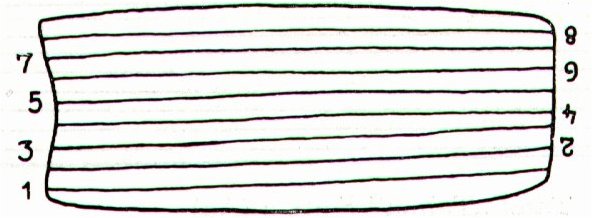
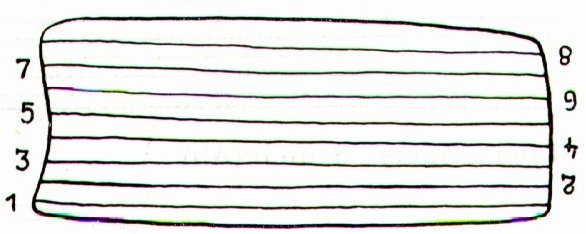
According to Manuscript E there were 5 kinds of banana brought
onboard the Royal Double Canoe
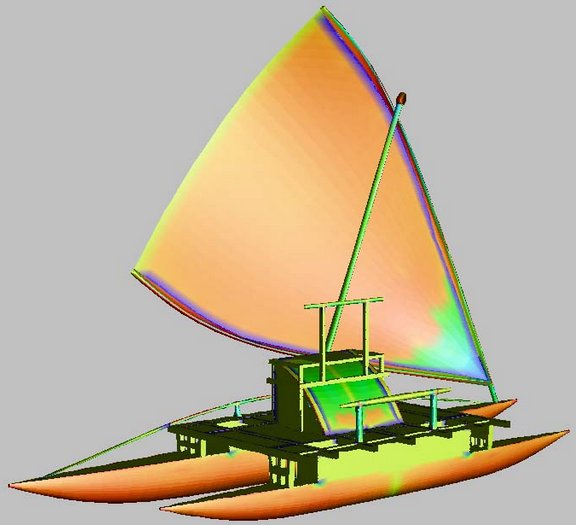
and assuming 1 right ascension day
for each kind of plant
we will find the 'banana plantation' at the beginning of
side a. The preceding water yams
and sweet potatoes were
arranged so they would stretch to the end of the back side of
the year (as regarded from a point north of the equator - in
Hiva).
|
Te Takapau (*0)
SIRRAH |
UHI |
KUMARA |
|
38 |
BHARANI (*41) |
20 |
BEID (*62) |
|
63 days = 9 weeks |
... the creators of Manuscript E enumerated
only 5 species of banana shoots although there were 6 such on
Easter Island ...
|
he maika [E:67] |
|
- |
origo |
he ri'o |
|
1 |
*1 |
he koro tea. |
a Teke. a Oti. |
|
2 |
*2 |
he hihi. |
|
3 |
*3 |
he pukapuka. |
|
4 |
*4 |
he pia. |
|
5 |
*5 |
he nahoo. |
|
Maika.
Banana (Musa sapientum).
Ancient varieties were called ri'o, hihi,
korotea, pia, pukapuka, naho'o. Vanaga. Meika,
banana. Pau., Mgv.: meika, id. Mq.: meika,
meia, id. Ta.: meia, id.
Churchill.

366 - 365 = 6 - 5 = 360 - 354. |
The last 23 days of side b on the G tablet were 'covered up'
('dressed', puo);
|
FEBR 26 (57 = 80 - 23) |
21 |
MARCH 20 (*364) |
|
 |
 |
|
Gb8-8 → 64 |
Gb8-30 (242 = 2 * 11 * 11) |
|
BHARANI (*41) |
HYADUM I (*63) |
|
May 1 (121) |
May 23 (143 = 135 + 8) |
|
"March 21 (0h) |
"April 12 (102) |
|
23
(= 359 - 2 * 168) |
probably because it was important that all
the sweet potatoes should be below the surface of the Earth -
the rays from the Sun would otherwise destroy them.
... A crack opened up in the ground, and
the Rat was put down into the pit, to rest there. - he
hakatopa i te kioe.ki raro ki te rua.he hakarere.
(Where) he was nourished by sweet potatoes. - he
hangai.hai kumara. [E: 4]
... Another year passed, and a man by the
name of Ure Honu went to work in his banana plantation.
He went and came to the last part, to the 'head' (i.e., the
upper part of the banana plantation), to the end of the banana
plantation. The sun was standing just right for Ure Honu
to clean out the weeds from the banana plantation.
On the first day he hoed the weeds. That went
on all day, and then evening came. Suddenly
a rat came from the middle of the banana
plantation. Ure Honu saw it and ran after it. But
it disappeared and he could not catch it. On the second day of
hoeing, the same thing happened with the rat. It ran away, and
he could not catch it. On the third day, he reached the 'head'
of the bananas and finished the work in the plantation. Again
the rat ran away, and Ure Honu followed it. It ran and
slipped into the hole of a stone. He poked after it, lifted up
the stone, and saw that the skull was (in the hole) of the
stone. (The rat was) a spirit of the skull (he kuhane o te
puoko). Ure Honu
was amazed and said, 'How beautiful you are!
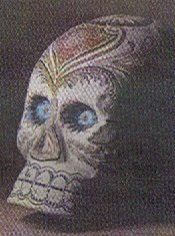
In the head of the new bananas is a skull,
painted with yellow root and with a strip of barkcloth around
it.'

Ure Honu stayed for a while, (then) he went away and
covered the roof of his house in Vai Matā. It was a new
house. He took the very large skull, which he had found at the
head of the banana plantation, and hung it up in the new house.
He tied it up in the framework of the roof (hahanga) and
left it hanging there ... (The Eighth Island, pp. 220-221)
|
- |
origo |
1 he koro tea. |
2 he hihi. |
3 he pukapuka. |
|
Koro. 1. Father (seems to be
an older word than matu'a tamâroa). 2. Feast,
festival; this is the generic term for feasts
featuring songs and banquetting; koro hakaopo,
feast where men and women danced. 3. When (also:
ana koro); ana koro oho au ki Anakena,
when I go to Anakena; in case, koro haga e
îa, in case he wants it. Vanaga. If.
Korokoro, To clack the tongue (kurukuru).
Churchill. Ma.: aokoro, pukoro, a halo
around the moon. Vi.: virikoro, a circle
around the moon. There is a complete accord from
Efaté through Viti to Polynesia in the main use of
this stem and in the particular use which is set to
itself apart. In Efaté koro answers equally
well for fence and for halo. In the marked advance
which characterizes social life in Viti and among
the Maori the need has been felt of qualifying
koro in some distinctive manner when its
reference is celestial. In Viti virimbai has
the meaning of putting up a fence (mbai
fence); viri does not appear independently in
this use, but it is undoubtedly homogenetic with
Samoan vili, which has a basic meaning of
going around; virikoro then signifies the
ring-fence-that-goes-around, sc. the moon. In the
Maori, aokoro is the cloud-fence. Churchill
2. |
|
MARCH 20 (*364) |
0h |
22 (*1) |
23 |
24 (83) |
 |
no glyph |
 |
 |
 |
|
Gb8-30
(242) |
Ga1-1 |
Ga1-2 |
Ga1-3 |
|
Al Dabarān-2 (The Follower)
HYADUM I
= γ Tauri
(63.4)
*22.0 = *63.4 - *41.4 |
HYADUM
II
= δ¹ Tauri
(64.2) |
Net-19 (Crow)
AIN
(Eye) =
ε Tauri,
θ¹
Tauri,
θ²
Tauri (65.7) |
no star
listed (66) |
no star
listed (67) |
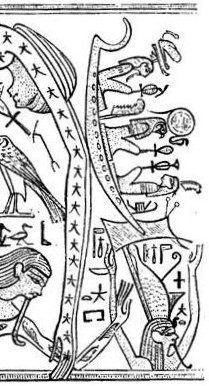
... There was no
water in the village. The lakes and rivers were dry.
Raven and Crow, two young girls who were having
their first menstrual courses, were told to go and
draw water from the ocean. Finding the journey too
long, Raven decided just to urinate into her
basket-bucket. She decieved no one and was severly
scolded. Crow returned much later but with drinking
water. As a punishment, Raven was condemned never to
find water in the summer; only in winter would she
find something to drink. For that reason the Raven
never drinks during the hot months; she speaks with
a raucous voice because of her dry throat
... |
|
May 23 |
24 |
25 (145) |
26 (*66) |
27 |
|
°May 19 |
20 |
21 (*61) |
22 (142) |
23 |
|
'April 26 |
27 |
28 (118) |
29 (*39) |
30 |
|
"April 12 |
13 |
14 (104) |
15 (*25) |
16 (471 = 314 *
1½) |
|
CLOSE TO THE FULL
MOON: |
|
SEPT 19 |
20 (*183) |
21 (264) |
EQUINOX |
23 |
|
YED POSTERIOR (Hand Behind) =
ε
Ophiuchi,
RUKBALGETHI SHEMALI
(Northern Knee of the Giant) =
τ
Herculis
(246.6).
δ
Apodis (246.7),
ο
Scorpii (246.8) |
Heart-5 (Fox)
σ
Scorpii
(247.0),
HEJIAN = γ Herculis
(247.2),
ψ
Ophiuchi (247.7) |
ρ
Ophiuchi (248.1),
KAJAM
(Club)
=
ω
Herculis
(248.3),
χ
Ophiuchi (248.5),
SHE LOW (Market Tower) = υ Ophiuchi,
Tr.
Austr. (248.7), ζ Tr. Austr. (248.8) |
Al Kalb-16 (The Heart) /
Jyeshtha-18 (Eldest) /
ANA-MUA-1 (Entrance pillar)
ANTARES
= α Scorpii
(249.1),
MARFIK (Elbow) = λ Ophiuchi,
φ Ophiuchi (249.5), ω Ophiuchi (249.8) |
γ Apodis (250.1), σ Herculis (250.3), θ Tr. Austr.
(250.6), τ Scorpii (250.7) |
|
... Proclus
informs us that the fox star nibbles continuously at
the thong of the yoke which holds together heaven
and earth; German folklore adds that when the fox
succeeds, the world will come to its end. This fox
star is no other than Alcor, the small star g
near zeta Ursae Majoris (in India Arundati,
the common wife of the Seven Rishis, alpha-eta Ursae
...
 |
|
Nov 22 |
23 (327) |
24 |
25 (*249) |
26 |
|
°Nov 18 |
19 |
20 (*244) |
21 (325) |
22 |
|
'Oct 26 |
27 (300) |
28 |
29 (*222) |
30 |
|
"Oct 12 |
13 (286) |
14 |
15 (*208) |
16 |
 |
There could not be 6 varieties of bananas because one of them
should be in the middle (ki roto).
Evidently the banana place represented the beginning of the new 'world
order'.
Here was the Crow who brought fresh water.
... There was no water in the village. The lakes and rivers were
dry. Raven and Crow, two young girls who were having their first
menstrual courses, were told to go and draw water from the
ocean. Finding the journey too long, Raven decided just to
urinate into her basket-bucket. She decieved no one and was
severly scolded. Crow returned much later but with drinking
water. As a punishment, Raven was condemned never to find water
in the summer; only in winter would she find something to drink.
For that reason the Raven never drinks during the hot months;
she speaks with a raucous voice because of her dry throat
...
Here the power generator was found and here Makoi marked
his Independence Day.
... Up to the present time, fertility spells
for fowls have played an important role. Especially effective
were the so-called 'chicken skulls' (puoko moa) - that
is, the skulls of dead chiefs, often marked by incisions, that
were considered a source of mana. Their task is explained
as follows: 'The skulls of the chiefs are for the chicken, so
that thousands may be born' (te puoko ariki mo te moa, mo
topa o te piere) ... As long as the source of mana is kept
in the house, the hens are impregnated (he rei te moa i te
uha), they lay eggs (he ne'ine'i te uha i te mamari),
and the chicks are hatched (he topa te maanga). After a
period of time, the beneficial skull has to be removed, because
otherwise the hens become exhausted from laying eggs ...
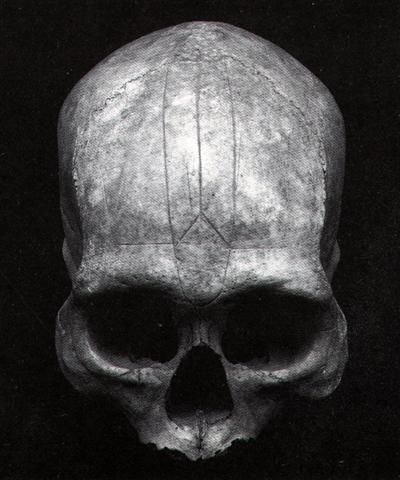
... Makoi replied, 'There are indeed all
those places. I did not forget them at all (? kai viri kai
viri) when I saw them (text corrected, i-ui-nei). I
alone saw no fewer than four of my places, and I returned here
only because night was falling'. Then Ira spoke again: 'How did
you name them, last-born [hangupotu]?' Makoi replied,
'This is what happened, this is how I gave the names. I wrote (ta
[?]) 'Te Manavai A Hau Maka' on the surface of a banana leaf (kaka),
and this is how I left it'. This is how Makoi remembered it.
No sooner had he said this, when Ira grew
angry and quarreled [he kakai] with Makoi. He said the
following (to him): 'You did not pay attention, last-born, and
you did not [tae] give the (full) name. This is how it
should be [Penei]: the Manavai of Hau Maka of Hiva, in
memory (mo aringa ora) of the father, of his dream
soul'. Makoi replied, 'In Hiva the land belongs to him - the
land here is mine, not his [tae oona]!' They stayed
(there longer), on the fifth day of the month of July
('Anakena'), they all got up, went downhill [he turu],
went on, and reached Hanga Te Pau ... [E:21]
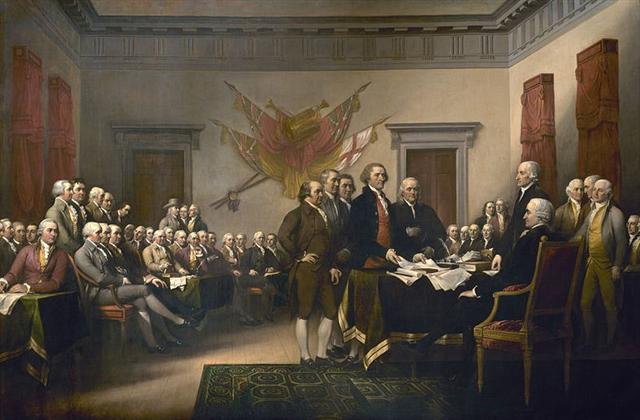

|












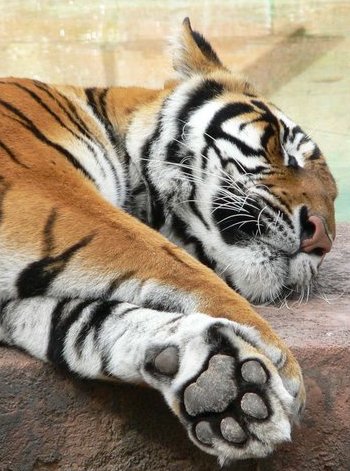

.jpg)
